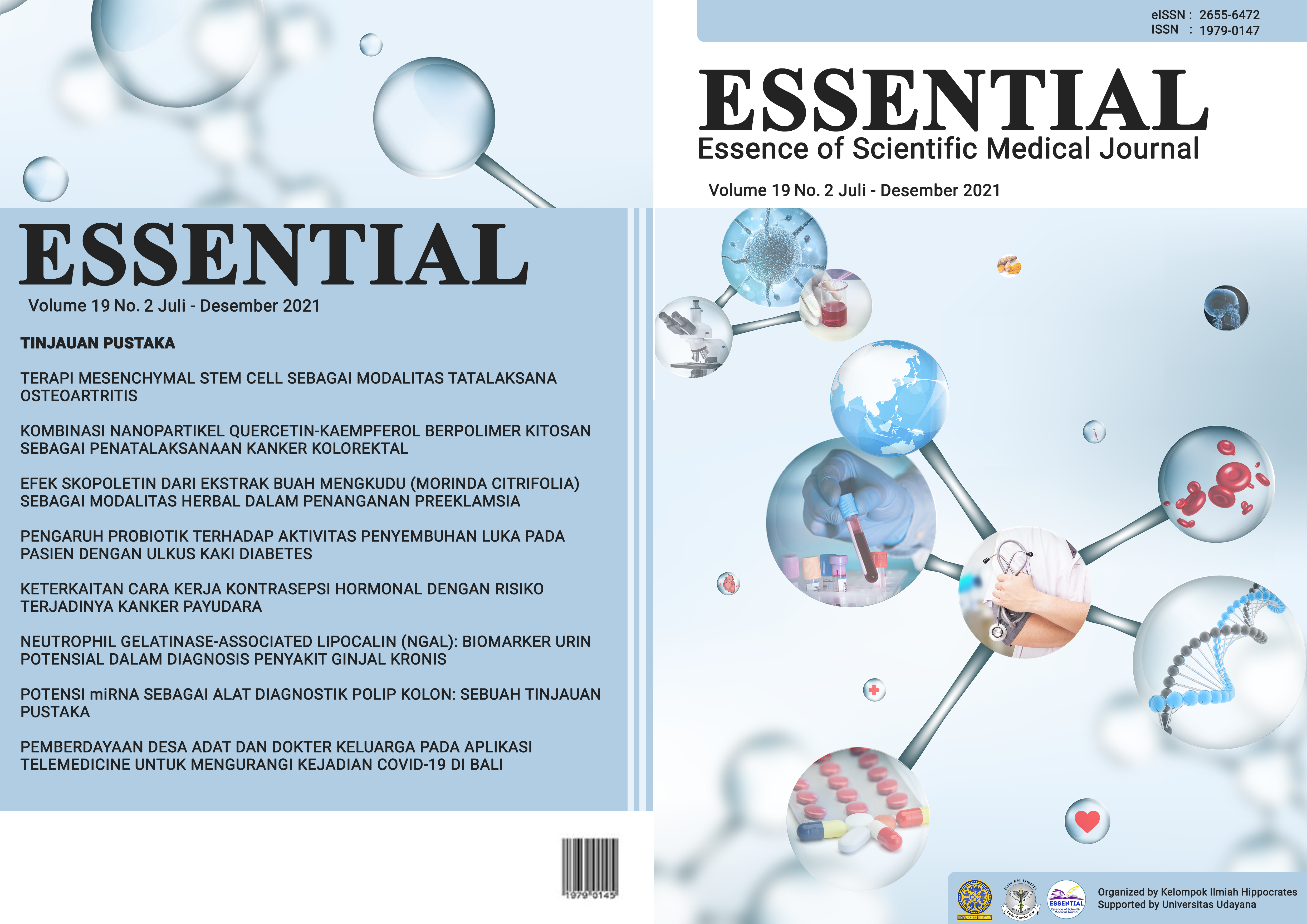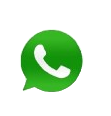Kombinasi Nanopartikel Quercetin-Kaempferol Berpolimer Kitosan sebagai Penatalaksanaan Kanker Kolorektal
Abstract
ABSTRAK
Pendahuluan: Kanker kolorektal merupakan jenis kanker yang berasal dari jaringan usus besar. Kanker kolorektal telah mengakibatkan 2 juta kasus baru dan 1 juta kematian secara global. Di Indonesia, prevalensi kanker kolorektal adalah 12,8% per 100.000 penduduk usia dewasa dengan mortalitas sebesar 9,5%. Penanganan kanker kolorektal saat ini seperti pembedahan, radioterapi, dan pemberian obat anti-kanker dinilai kurang efektif karena mahal dan memicu efek samping.
Pembahasan: Quercetin dan kaempferol merupakan zat flavonoid yang dapat mengobati kanker kolorektal melalui serangkaian mekanisme pada tahapan proses karsinogenesis, yaitu menghalangi proliferasi dengan menghambat NF-kB, meningkatkan proses apoptosis dengan memengaruhi gen CASP2, CLEC4M, dan NTR3K, serta menimbulkan efek antiangiogenesis dengan menurunkan ekspresi MMP-2 dan MMP-9. Keterbatasan modalitas ini ialah rendahnya bioavailabilitasnya sehingga dikemas dalam bentuk nanopartikel berpolimer kitosan. Quercetin terbanyak diperoleh dari kulit bawang sedangkan kaempferol diperoleh dari daun bawang. Pembuatan nanopartikel kitosan quercetin-kaempferol menggunakan metode top down (maserasi). Modalitas ini diadministrasikan secara oral. Kitosan sebagai polimer akan larut saat memasuki asam lambung. Farmakokinetik dari modalitas akan dimulai dengan absorpsi oleh usus halus dan diakhiri oleh ekskresi oleh ginjal serta eliminasi oleh usus besar. Quercetin 15 ?M-30 ?M mampu menurunkan cell viability menjadi 63 ± 1,3% hingga 41 ± 0,3%. Sedangkan, kaempferol 30 ?M-60 ?M mampu menurunkan cell viability menjadi 62 ± 0,83% hingga 26 ± 0,91%.
Simpulan: Kombinasi quercetin dan kaempferol dapat meningkatkan proses apoptosis secara eksternal maupun internal serta menghambat proliferasi dan angiogenesis sel kanker kolorektal.
Kata kunci: Kanker kolorektal, Quercetin, Kaempferol
Downloads
References
2. Hulaima IS, Carolia N. OAINS sebagai Kemoprofilaksis Kanker Kolorektal. Majority. 2016;5(1).
3. Campos FG. Colorectal cancer in young adults: A difficult challenge. World J Gastroenterol. 2017;23(28). doi:10.3748/wjg.v23.i28.5041
4. Taggarshe D, Rehil N, Sharma S, Flynn JC, Damadi A. Colorectal cancer: are the “young” being overlooked? Am J Surg. 2013;205(3). doi:10.1016/j.amjsurg.2012.10.016
5. Komite Penanggulangan Kanker Nasional. Pedoman nasional pelayanan kedokteran tata laksana kanker kolorektal. http://kanker.kemkes.go.id/guidelines/PNPKkolorektal.pdf. Published July 2018.
6. Rawla P, Sunkara T, Barsouk A. Epidemiology of colorectal cancer: incidence, mortality, survival, and risk factors. Gastroenterol Rev. 2018;14(2). doi:10.5114/pg.2018.81072
7. Husna T. Pengaruh Sitotoksik Ekstrak Etanol Daun Kemangi (Ocimum sanctum) Terhadap Sel MCF-7 dan Sel T47D. 2018.
8. Basyid F, Adi K. Segmentasi Citra Medis Untuk Pengenalan Objek Kanker Menggunakan Metode Active Contour. Youngster Phys J. 2014;3(3).
9. Deng R, Shi L, Zhu W, et al. Pharmacokinetics-based Dose Management of 5-Fluorouracil Clinical Research in Advanced Colorectal Cancer Treatment. Mini-Reviews Med Chem. 2020;20(2). doi:10.2174/1389557519666191011154923
10. Zils K, Wilhelm M, Reeh T, Bielack S. Bullous Variant of Acral Erythema in a Child After High-Dose Methotrexate. Pediatr Hematol Oncol. 2012;29(4). doi:10.3109/08880018.2012.665982
11. Kumar DRN, George VC, Suresh PK, Kumar RA. Cytotoxicity, Apoptosis Induction and Anti-Metastatic Potential of Oroxylum indicum in Human Breast Cancer Cells. Asian Pacific J Cancer Prev. 2012;13(6). doi:10.7314/apjcp.2012.13.6.2729
12. Zhang X-A, Zhang S, Yin Q, Zhang J. Quercetin induces human colon cancer cells apoptosis by inhibiting the nuclear factor-kappa B Pathway. Pharmacogn Mag. 2015;11(42). doi:10.4103/0973-1296.153096
13. Budisan L, Gulei D, Jurj A, et al. Inhibitory Effect of CAPE and Kaempferol in Colon Cancer Cell Lines—Possible Implications in New Therapeutic Strategies. Int J Mol Sci. 2019;20(5). doi:10.3390/ijms20051199
14. Jaramillo Carmona S, López S, Abia R, et al. Combination of quercetin and kaempferol enhances in vitro cytotoxicity on human colon cancer (HCT-116) cells. Rec Nat Prod. 2014;8(3).
15. Steen N Van Der, Deben C, Deschoolmeester V, et al. Better to be alone than in bad company: The antagonistic effect of cisplatin and crizotinib combination therapy in non-small cell lung cancer. World J Clin Oncol. 2016;7(6). doi:10.5306/wjco.v7.i6.425
16. Wang Z, Wang N, Chen J, Shen J. Emerging Glycolysis Targeting and Drug Discovery from Chinese Medicine in Cancer Therapy. Evidence-Based Complement Altern Med. 2012;2012. doi:10.1155/2012/873175
17. Wang S, Zhang J, Chen M, Wang Y. Delivering flavonoids into solid tumors using nanotechnologies. Expert Opin Drug Deliv. 2013;10(10). doi:10.1517/17425247.2013.807795
18. Grady WM, Markowitz SD. The Molecular Pathogenesis of Colorectal Cancer and Its Potential Application to Colorectal Cancer Screening. Dig Dis Sci. 2014;60(3). doi:10.1007/s10620-014-3444-4
19. Kuipers EJ, Grady WM, Lieberman D, et al. Colorectal cancer. Nat Rev Dis Prim. 2015;1. doi:10.1038/nrdp.2015.65
20. Brodowsk KM. Natural flavonoids: classification, potential role,and application of flavonoid analogues. Eur J Biol Res. 2017;7(2). doi:10.5281/zenodo.545778
21. Hashemzaei M, Far AD, Yari A, et al. Anticancer and apoptosis-inducing effects of quercetin in vitro and in vivo. Oncol Rep. 2017;38(2). doi:10.3892/or.2017.5766
22. Tungmunnithum D, Thongboonyou A, Pholboon A, Yangsabai A. Flavonoids and Other Phenolic Compounds from Medicinal Plants for Pharmaceutical and Medical Aspects: An Overview. Medicines. 2018;5(3). doi:10.3390/medicines5030093
23. Li Y, Zhang T, Chen G. Flavonoids and Colorectal Cancer Prevention. Antioxidants. 2018;7(12). doi:10.3390/antiox7120187
24. Darband SG, Kaviani M, Yousefi B, et al. Quercetin: A functional dietary flavonoid with potential chemo-preventive properties in colorectal cancer. J Cell Physiol. 2018;233(9). doi:10.1002/jcp.26595
25. Kim H-S, Wannatung T, Lee S, et al. Quercetin enhances hypoxia-mediated apoptosis via direct inhibition of AMPK activity in HCT116 colon cancer. Apoptosis. 2012;17(9). doi:10.1007/s10495-012-0719-0
26. Vadde R, Radhakrishnan S, Eranda Karunathilake Kurundu H, Reddivari L, Vanamala JKP. Indian gooseberry (Emblica officinalis Gaertn.) suppresses cell proliferation and induces apoptosis in human colon cancer stem cells independent of p53 status via suppression of c-Myc and cyclin D1. J Funct Foods. 2016;25. doi:10.1016/j.jff.2016.06.007
27. Song Y, Han M, Zhang X. Quercetin suppresses the migration and invasion in human colon cancer Caco-2 cells through regulating toll-like receptor 4/Nuclear Factor-kappa B pathway. Pharmacogn Mag. 2016;12(46). doi:10.4103/0973-1296.182154
28. Sak K. Cytotoxicity of dietary flavonoids on different human cancer types. Pharmacogn Rev. 2014;8(16). doi:10.4103/0973-7847.134247
29. M. Calderon-Montano J, Burgos-Moron E, Perez-Guerrero C, Lopez-Lazaro M. A Review on the Dietary Flavonoid Kaempferol. Mini-Reviews Med Chem. 2011;11(4). doi:10.2174/138955711795305335
30. Puccini J, Dorstyn L, Kumar S. Caspase-2 as a tumour suppressor. Cell Death Differ. 2013;20(9). doi:10.1038/cdd.2013.87
31. Luo Y, Kaz AM, Kanngurn S, et al. NTRK3 Is a Potential Tumor Suppressor Gene Commonly Inactivated by Epigenetic Mechanisms in Colorectal Cancer. Scott HS, ed. PLoS Genet. 2013;9(7). doi:10.1371/journal.pgen.1003552
32. Na H, Liu X, Li X, et al. Novel roles of DC-SIGNR in colon cancer cell adhesion, migration, invasion, and liver metastasis. J Hematol Oncol. 2017;10(1). doi:10.1186/s13045-016-0383-x
33. Choi J-B, Kim J-H, Lee H, Pak J-N, Shim BS, Kim S-H. Reactive Oxygen Species and p53 Mediated Activation of p38 and Caspases is Critically Involved in Kaempferol Induced Apoptosis in Colorectal Cancer Cells. J Agric Food Chem. 2018;66(38). doi:10.1021/acs.jafc.8b02656
34. Abotaleb M, Samuel S, Varghese E, et al. Flavonoids in Cancer and Apoptosis. Cancers (Basel). 2018;11(1). doi:10.3390/cancers11010028
35. Saboktakin MR, Tabatabaie RM, Maharramov A, Ramazanov MA. Synthesis and in vitro evaluation of carboxymethyl starch–chitosan nanoparticles as drug delivery system to the colon. Int J Biol Macromol. 2011;48(3). doi:10.1016/j.ijbiomac.2010.10.005
36. Gamboa JM, Leong KW. In vitro and in vivo models for the study of oral delivery of nanoparticles. Adv Drug Deliv Rev. 2013;65(6). doi:10.1016/j.addr.2013.01.003
37. Baksi R, Singh DP, Borse SP, Rana R, Sharma V, Nivsarkar M. In vitro and in vivo anticancer efficacy potential of Quercetin loaded polymeric nanoparticles. Biomed Pharmacother. 2018;106. doi:10.1016/j.biopha.2018.07.106
38. Iqbal P, Preece JA, Mendes PM. Nanotechnology: The “Top-Down” and “Bottom-Up” Approaches. Supramol Chem. 2012. doi:10.1002/9780470661345.smc195
39. Kurniasari D, Atun S. Pembuatan dan Karakterisasi Nanopartikel Ekstrak Etanol Temu Kunci (Boesenbergia pandurata) pada Berbagai Variasi Komposisi Kitosan. J Sains Dasar. 2017;6(1). doi:10.21831/jsd.v6i1.13610
40. Riahi-Chebbi I, Souid S, Othman H, et al. The Phenolic compound Kaempferol overcomes 5-fluorouracil resistance in human resistant LS174 colon cancer cells. Sci Rep. 2019;9(1). doi:10.1038/s41598-018-36808-z
41. Sulanjani I, Andini MD, Halim M. Dasar-Dasar Farmakologi 1. 1st ed. (Nila A, ed.). Direktorat Pembinaan SMK; 2013.
42. Colombo M, de Lima Melchiades G, Michels LR, et al. Solid Dispersion of Kaempferol: Formulation Development, Characterization, and Oral Bioavailability Assessment. AAPS PharmSciTech. 2019;20(3). doi:10.1208/s12249-019-1318-y
43. Muxika A, Etxabide A, Uranga J, Guerrero P, de la Caba K. Chitosan as a bioactive polymer: Processing, properties and applications. Int J Biol Macromol. 2017;105(2). doi:10.1016/j.ijbiomac.2017.07.087
44. Lu H, Yang G, Ran F, et al. Polymer-functionalized mesoporous carbon nanoparticles on overcoming multiple barriers and improving oral bioavailability of Probucol. Carbohydr Polym. 2020;229. doi:10.1016/j.carbpol.2019.115508
45. de Oliveira Pedro R, Hoffmann S, Pereira S, Goycoolea FM, Schmitt CC, Neumann MG. Self-assembled amphiphilic chitosan nanoparticles for quercetin delivery to breast cancer cells. Eur J Pharm Biopharm. 2018;131. doi:10.1016/j.ejpb.2018.08.009
46. Khan F, Niaz K, Maqbool F, et al. Molecular Targets Underlying the Anticancer Effects of Quercetin: An Update. Nutrients. 2016;8(9). doi:10.3390/nu8090529
47. Lee H, Cho H, Yu R, Lee K, Chun H, Park J. Mechanisms Underlying Apoptosis-Inducing Effects of Kaempferol in HT-29 Human Colon Cancer Cells. Int J Mol Sci. 2014;15(2). doi:10.3390/ijms15022722
48. Fuchs O. Transcription Factor NF-κB Inhibitors as Single Therapeutic Agents or in Combination with Classical Chemotherapeutic Agents for the Treatment of Hematologic Malignancies. Curr Mol Pharmacol. 2010;3(3). doi:10.2174/1874467211003030098
49. Liu B, Qu L, Yan S. Cyclooxygenase-2 promotes tumor growth and suppresses tumor immunity. Cancer Cell Int. 2015;15(1). doi:10.1186/s12935-015-0260-7
50. Chen B-J, Wu Y-L, Tanaka Y, Zhang W. Small Molecules Targeting c-Myc Oncogene: Promising Anti-Cancer Therapeutics. Int J Biol Sci. 2014;10(10). doi:10.7150/ijbs.10190
51. Park S, Choi J. Inhibition of β-catenin/Tcf signaling by flavonoids. J Cell Biochem. 2010;110(6). doi:10.1002/jcb.22654
52. Ademosun AO, Oboh G, Passamonti S, et al. Phenolic composition of orange peels and modulation of redox status and matrix metalloproteinase activities in primary (Caco-2) and metastatic (LoVo and LoVo/ADR) colon cancer cells. Eur Food Res Technol. 2016;242(11). doi:10.1007/s00217-016-2694-0
53. Xiao X, Shi D, Liu L, et al. Quercetin Suppresses Cyclooxygenase-2 Expression and Angiogenesis through Inactivation of P300 Signaling. Tao Q, ed. PLoS One. 2011;6(8). doi:10.1371/journal.pone.0022934
54. Feng J, Song D, Jiang SY, et al. Quercetin restrains TGF-β1-induced epithelial–mesenchymal transition by inhibiting Twist1 and regulating E-cadherin expression. Biochem Biophys Res Commun. 2018;498(1):132-138. doi:10.1016/j.bbrc.2018.02.044
55. Saud SM, Young MR, Jones-Hall YL, et al. Chemopreventive Activity of Plant Flavonoid Isorhamnetin in Colorectal Cancer Is Mediated by Oncogenic Src and -Catenin. Cancer Res. 2013;73(17). doi:10.1158/0008-5472.can-13-0525


 SUBMISSION
SUBMISSION
















